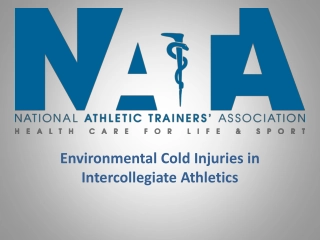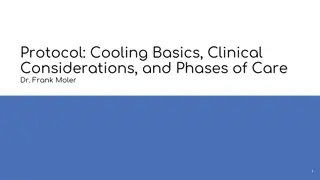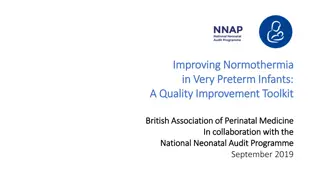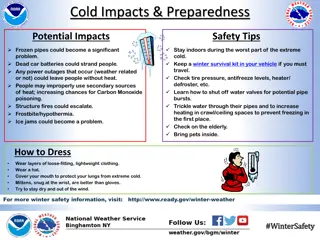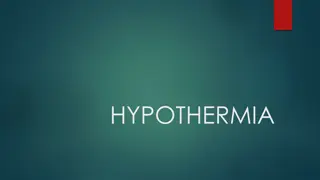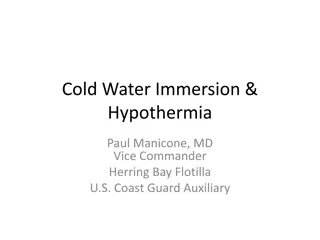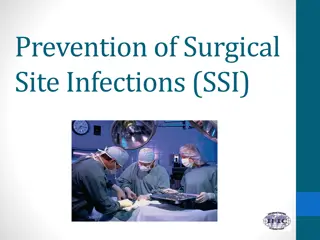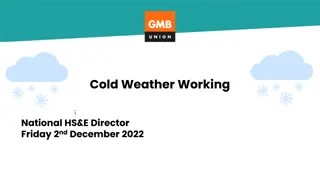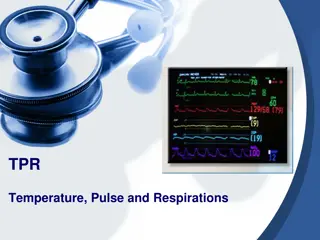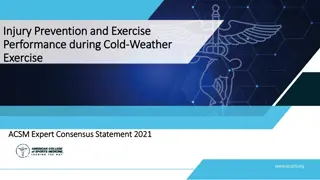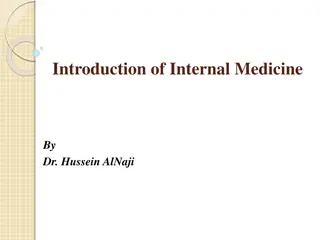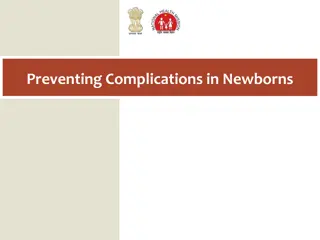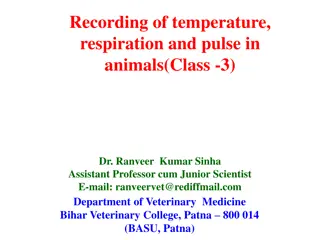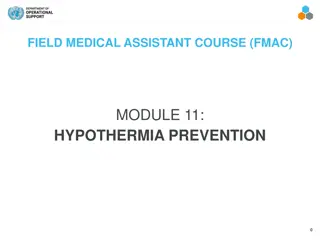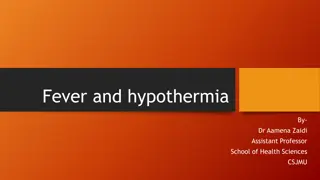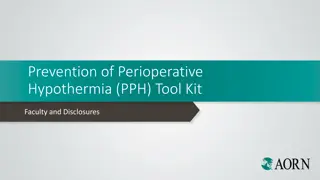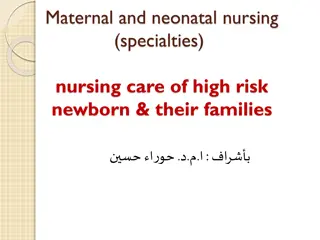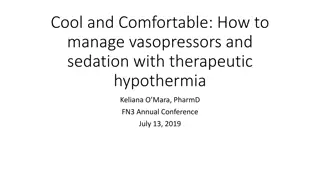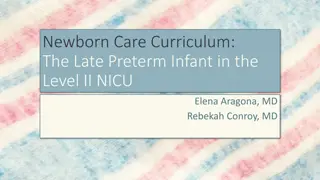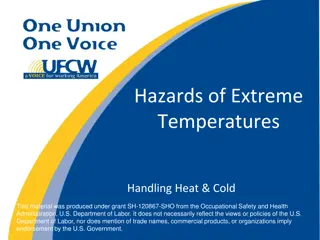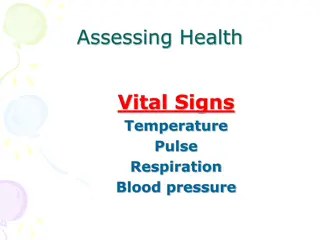Environmental Cold Injuries in Intercollegiate Athletics
Learn about environmental cold injuries in intercollegiate athletics, including hypothermia, frostbite, and chilblains. Understand the recognition signs and proper treatment methods to address these conditions promptly.
6 views • 10 slides
Protocol: Cooling Basics, Clinical Considerations, and Phases of Care
The essentials of cooling protocols and clinical considerations, focusing on temperature management, thermoregulation basics, effects of hypothermia/cooling, central temperature measurement, and factors influencing target temperature. It emphasizes the importance of safe monitoring and application o
2 views • 72 slides
Understanding Cooling Basics and Clinical Considerations for Patient Care
This presentation delves into essential information on temperature regulation and the application of cooling in patient care. It covers topics such as thermoregulation basics, physiological effects of hypothermia, central temperature measurement, and factors influencing target temperature. The talk
2 views • 72 slides
Quality Improvement Toolkit for Improving Normothermia in Very Preterm Infants
This resource provides a comprehensive toolkit developed by the British Association of Perinatal Medicine in collaboration with the National Neonatal Audit Programme to assist clinicians in neonatal units in delivering normothermia to very preterm infants. It includes evidence-based interventions, d
1 views • 17 slides
Winter Safety Preparedness Tips and Cold Weather Hazards
Learn how to prepare for extreme cold weather conditions to stay safe and prevent potential dangers like frozen pipes, car battery issues, power outages, and more. Discover safety tips, warning signs of hypothermia and frostbite, wind chill effects, and practical steps for home and car winter prepar
0 views • 7 slides
Understanding Hypothermia: Symptoms, Prevention, and Treatment
Hypothermia is a condition where the body's temperature drops in response to cold. It can range from mild to severe, with potentially deadly consequences. Learn how to recognize and prevent hypothermia, including tips on measuring temperature in the field and preventing heat loss through proper clot
0 views • 20 slides
Survival Strategies and Risks in Cold Water Immersion and Hypothermia Scenarios
Explore the critical information on cold water immersion and hypothermia, including severity levels, thermal regulations, and survival tips. Understand the dangers of reflexive gasp, stages of incapacitation, and the crucial 10 minutes window for purposeful movement. Learn how to differentiate betwe
0 views • 30 slides
Southern Uplands Mountain Weather Forecast for Thursday, 4th March 2021
Detailed mountain weather forecast for the Southern Uplands on Thursday, 4th March 2021. Expect snow showers or flurries, chilly winds, and blustery conditions on higher terrain. Snow flurries are likely in certain areas, with reduced visibility around showers. Temperatures will be cold, dropping to
0 views • 6 slides
Prevention of Surgical Site Infections: Key Factors and Recommendations
Surgical site infections (SSIs) are a significant concern in healthcare settings, with 25% of healthcare-associated infections being SSIs. They are preventable, but still pose challenges due to multifactorial causes. Risk factors include uncontrolled diabetes, obesity, smoking, and length of preoper
2 views • 28 slides
Mountain Maladies: How to Prevent and Manage Common Outdoor Health Risks
Explore the risks of outdoor activities, from dehydration to hypothermia, and learn how to identify symptoms and take preventive measures. Discover the importance of staying hydrated, recognizing heat exhaustion, and preventing hypothermia by dressing appropriately and avoiding wet conditions.
0 views • 17 slides
Understanding the Risks of Working in Cold Weather
Working in cold weather conditions can lead to various health risks, including frostbite, hypothermia, and musculoskeletal disorders. Employers should have policies and procedures in place to protect workers from the impacts of extreme cold, such as reduced performance and increased risk of accident
0 views • 20 slides
Understanding Temperature Measurement in Healthcare
Temperature, Pulse, and Respirations are vital signs used to assess a patient's health. Temperature can be measured through various methods such as oral, rectal, axillary, tympanic, and temporal routes using different types of thermometers. It's important to know the normal temperature ranges for di
3 views • 39 slides
Cold Weather Exercise Injury Prevention and Treatment Guidelines
This expert consensus statement by the ACSM provides comprehensive information on preventing and treating cold injuries during exercise. It covers frostbite, hypothermia, snow blindness, and other cold-related conditions, emphasizing the importance of understanding risk factors, prevention strategie
1 views • 17 slides
Understanding Body Temperature Regulation in Internal Medicine
Internal Medicine, spearheaded by Dr. Hussein AlNaji, focuses on preventing, diagnosing, and treating internal diseases like hypothermia, hyperthermia, and fever. The body maintains a constant core temperature through heat production and loss mechanisms. Heat is transferred through convection, condu
0 views • 11 slides
Preventing Complications in Newborns: Tips and Strategies
Learn effective ways to prevent common complications in newborns, such as hypothermia, infection, and breathing difficulties. Discover practical tips for maintaining the baby's health and well-being during the crucial early stages, including measures to prevent hypothermia, infection, and breathing
0 views • 6 slides
Animal Temperature, Respiration, and Pulse Recording Guide
Learn how to record the temperature, respiration, and pulse in animals for diagnosing febrile diseases and monitoring health. Understand the techniques, precautions, factors affecting temperature, and causes of hypothermia in animals. Follow Dr. Ranveer Kumar Sinha's comprehensive instructions to en
0 views • 20 slides
Comprehensive Hypothermia Prevention Measures in Tactical Field Care
Hypothermia is a critical concern in trauma casualties, especially in cold environments. This module covers the importance of preventing hypothermia, strategies to minimize exposure, and active and passive warming techniques. Proper hypothermia prevention can significantly impact the outcome of trau
0 views • 16 slides
Understanding Fever and Hypothermia: Body Temperature Regulation
Body temperature is the balance between heat production and heat loss, crucial for maintaining health. Fever and hypothermia are conditions where body temperature is elevated or decreased respectively. Factors like age, exercise, hormonal levels, stress, and environment can affect body temperature.
0 views • 10 slides
Prevention of Perioperative Hypothermia (PPH) Tool Kit Faculty and Disclosures
AORN collaborates with Victoria Steelman, PhD, RN, CNOR, FAAN, and The University of Iowa to offer the Prevention of Perioperative Hypothermia (PPH) Tool Kit, funded by the Agency for Healthcare Research and Quality. The kit features expert faculty members, including Susan K. Bakewell, Ellice Mellin
0 views • 4 slides
Precision Medicine Approach for Post-cardiac Arrest Care Study
Study aims to develop novel biomarkers for optimizing hypothermia duration post-cardiac arrest and predicting 90-day function. Overcoming past limitations in neuroprognostication research, the study utilizes a multicenter approach and standardizes post-resuscitation care protocols. Addressing challe
0 views • 13 slides
High-Risk Newborn Nursing Care and Factors
Maternal and neonatal nursing specialties focus on providing care for high-risk newborns and their families, who face conditions endangering the neonate's survival. Factors contributing to high-risk newborns include high-risk pregnancies, maternal medical illnesses like diabetes, labor complications
0 views • 25 slides
Managing Vasopressors and Sedation in Therapeutic Hypothermia
This presentation discusses the pathophysiology of hypotension in neonates, the role of vasopressors and sedation in neonates with HIE, and the cardiovascular and pulmonary vascular effects of therapeutic hypothermia. It emphasizes the importance of a pathophysiology-based approach to managing vasop
0 views • 66 slides
Newborn Care Curriculum for Late Preterm Infants in Level II NICU
This curriculum module focuses on the care of late preterm infants in Level II NICU settings, covering topics such as respiratory management, feeding difficulties, hypoglycemia, hypothermia, sepsis, hyperbilirubinemia, and discharge planning. It includes learning objectives, nursery care levels, phy
1 views • 42 slides
Understanding Haemorrhage and Its Impact in Surgery
Haemorrhage in surgery is a critical phenomenon leading to hypovolaemic shock, trauma-induced coagulopathy, and other complications. It involves ongoing bleeding, hypoperfusion, acidosis, and hypothermia, exacerbating the condition. Classification includes revealed and concealed haemorrhage, with pr
0 views • 33 slides
Understanding Death from Starvation and Cold: Mechanisms and Lesions
Starvation and cold can lead to death through specific mechanisms that affect the body's metabolism and tissue integrity. In cases of starvation, the body breaks down fat stores, leading to organ damage and eventual death. For cold-related deaths, exposure to extreme temperatures disrupts metabolic
0 views • 17 slides
Understanding the Hazards of Extreme Temperatures in the Workplace
Extreme temperatures, whether hot or cold, pose significant risks to worker health and safety. This material, developed by OSHA, highlights the dangers of heat and cold exposure, including heat stroke, hypothermia, and other related illnesses. The case study mentioned underscores the importance of p
0 views • 50 slides
Understanding Body Temperature Regulation and Factors Affecting It
Body temperature regulation is a complex process involving the balance of heat production and loss. Factors like age, hormones, stress, and environmental changes can influence body temperature. Heat production is affected by factors such as basal metabolic rate, muscle activity, fever, and sympathet
0 views • 24 slides
